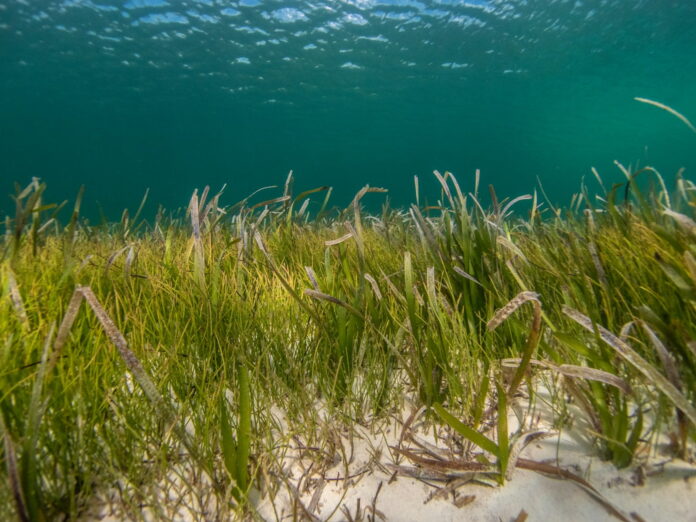Seagrass, often an overlooked component of the marine ecosystem, is a powerful ally in the global effort to mitigate climate change. These underwater plants, which form dense meadows in shallow coastal regions around the world, possess remarkable abilities that extend far beyond providing habitat for marine life. Seagrass meadows are increasingly recognized for their significant role in carbon sequestration, earning them the title of hidden champions of carbon storage.
Unveiling Seagrass Superpowers
Seagrass possesses an array of superpowers that make it an exceptional component of the marine environment. These flowering plants, which are often mistaken for seaweed, are actually more closely related to terrestrial lilies and have adapted to live fully submerged in salty waters. One of their most noteworthy abilities is their high rate of photosynthesis, which not only contributes to oxygen production but also allows them to grow rapidly and store substantial amounts of carbon within their tissues and the surrounding sediment. This adaptation has enabled seagrass to become one of the most productive ecosystems on the planet.
Furthermore, seagrass beds stabilize the seafloor with their complex root systems, reducing erosion and trapping fine particles and organic matter. This process of trapping and stabilizing enhances sediment accumulation, which in turn captures and secures even more carbon over time. The longevity of seagrass also plays a crucial role in carbon storage, with some beds known to be thousands of years old, continually sequestering carbon throughout their existence. The resilience of seagrass, despite facing threats from human activities and climate change, further underscores its superpowers in maintaining the health and balance of coastal ecosystems.
However, the true extent of seagrass’s superpowers is still being uncovered. Recent studies suggest that seagrass meadows can sequester carbon at a rate up to 35 times faster than tropical rainforests. Despite covering only a small fraction of the total ocean floor, these meadows are estimated to be responsible for more than 10% of the ocean’s total carbon storage. The revelation of these superpowers positions seagrass as a critical player in global carbon dynamics and a valuable target for conservation and restoration efforts.
Seagrass Meadows: Carbon Sink Heroes
Seagrass meadows serve as carbon sink heroes, playing a significant role in reducing atmospheric carbon dioxide levels. The term “Blue Carbon” refers to the carbon captured by the world’s oceanic ecosystems, predominantly by mangroves, salt marshes, and notably, seagrass meadows. These underwater meadows are incredibly efficient at absorbing and storing carbon in their leaves, stems, roots, and the sediment below. The carbon stored in this way is often referred to as “sequestered” carbon, and it can remain trapped for centuries, making seagrass meadows vital to long-term carbon storage.
The efficiency of seagrass meadows as carbon sinks is largely due to the dense mats formed by their interwoven leaves, which create an environment with low oxygen levels that slows down the decomposition of organic material, including the plants themselves when they die. The slow decomposition rate means that carbon is retained in the sediment rather than being released back into the atmosphere. Additionally, the carbon-rich biomass of seagrass meadows continues to accumulate as the plants grow and expand, further increasing their capacity to store carbon.
However, the ability of seagrass meadows to act as carbon sinks is under threat due to human activities. Coastal development, pollution, and destructive fishing practices have led to a decline in seagrass populations globally. It is estimated that up to 7% of seagrass meadows are lost each year, which not only reduces the carbon storage potential of the oceans but also releases the stored carbon back into the atmosphere, exacerbating climate change. Protecting and restoring seagrass meadows is essential to safeguard their role as carbon sink heroes.
The Role of Seagrass in Climate Fight
In the global climate fight, seagrass plays an indispensable role in mitigating the effects of climate change. Their ability to absorb and store carbon at such high rates makes them a natural solution for reducing greenhouse gas concentrations in the atmosphere. As the urgency to address climate change intensifies, seagrass meadows are gaining recognition as a cost-effective and natural method for carbon dioxide removal, complementing technological solutions and emission reduction strategies.
The conservation and restoration of seagrass meadows are critical climate actions that provide a multitude of co-benefits. These include enhancing biodiversity, protecting coastlines from erosion, improving water quality, and supporting fisheries. By maintaining healthy seagrass ecosystems, we also preserve the livelihoods of many communities that depend on these habitats for food, income, and cultural identity. Additionally, healthy seagrass meadows can help buffer the impacts of ocean acidification, another consequence of rising atmospheric carbon dioxide levels.
Despite the clear benefits, seagrass conservation has not yet received the level of attention or funding commensurate with its importance in the climate fight. Increased awareness and understanding of the role of seagrass can lead to more robust policy measures and international cooperation to protect these valuable ecosystems. By incorporating seagrass preservation into climate policies and sustainability goals, we can harness the full potential of these underwater meadows to combat climate change and work towards a healthier planet.
Seagrass meadows are unsung heroes in our fight against climate change, with their extraordinary carbon storage capabilities and myriad ecological benefits. As hidden champions of carbon sequestration, they offer a natural and effective means of reducing atmospheric carbon levels and mitigating the impacts of global warming. By unveiling the superpowers of seagrass, recognizing its role as a carbon sink hero, and understanding its crucial position in the climate fight, we can take meaningful steps toward preserving and restoring these precious ecosystems. It is imperative that the global community prioritizes the conservation of seagrass to ensure that this hidden champion continues to thrive and assist us in securing a sustainable future.
